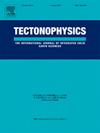Stress field near the fault edges of a medium-sized earthquake -Possibility of stress relaxation occurring before the earthquake
IF 2.6
3区 地球科学
Q2 GEOCHEMISTRY & GEOPHYSICS
引用次数: 0
Abstract
By analyzing aftershock focal mechanisms of a magnitude 5.6 earthquake, we estimated the stress field around the fault in detail, and found that the direction of the σ1 axis had deviated from horizontal near the fault ends in the hanging wall of the fault. This rotation was not seen before the earthquake, and is consistent with the stress changes caused by the earthquake. It is inferred from these results that the differential stress was very small before the earthquake near the fault ends. On the other hand, there was no rotation of the σ1 axis near the fault except for the ends of the fault, and then it is estimated that the differential stress before the earthquake at the center of the fault was quite large, much larger than the stress changes at the end of the fault. These results suggest that stress relaxation may have occurred near the fault ends before the earthquake. This is consistent with the results of the 2017 Central Tottori earthquake (M6.8), in which the stress state near the fault ends was estimated for the first time from a large amount of high-precision aftershock data. The present study is considered important because a wealth of data is available even before the earthquake, and the stress field before the earthquake can be regarded as homogeneous even near the fault, showing no rotation of the σ1 axis. In the future, it will be important to investigate whether this result holds for other earthquakes of different sizes.

中等地震断层边缘附近的应力场——地震前发生应力松弛的可能性
通过对一次5.6级地震余震震源机制的分析,详细估算了断层周围的应力场,发现断层上盘断层两端附近的σ1轴方向偏离水平方向。这种旋转在地震前是没有看到的,并且与地震引起的应力变化一致。从这些结果推断,地震前断层末端附近的应力差很小。另一方面,除断层末端外,断层附近没有σ1轴的旋转,因此可以推测,地震前断层中心的应力差很大,远远大于断层末端的应力变化。这些结果表明,在地震发生前,应力松弛可能已经发生在断层末端附近。这与2017年鸟取县中部(6.8级)地震的结果一致,在那次地震中,首次利用大量高精度余震数据估计了断层末端附近的应力状态。本研究具有重要意义,因为在地震发生前就有丰富的资料,地震前的应力场即使在断层附近也可以被认为是均匀的,没有显示出σ1轴的旋转。在未来,研究这一结果是否适用于其他不同规模的地震将是很重要的。
本文章由计算机程序翻译,如有差异,请以英文原文为准。
求助全文
约1分钟内获得全文
求助全文
来源期刊

Tectonophysics
地学-地球化学与地球物理
CiteScore
4.90
自引率
6.90%
发文量
300
审稿时长
6 months
期刊介绍:
The prime focus of Tectonophysics will be high-impact original research and reviews in the fields of kinematics, structure, composition, and dynamics of the solid arth at all scales. Tectonophysics particularly encourages submission of papers based on the integration of a multitude of geophysical, geological, geochemical, geodynamic, and geotectonic methods
 求助内容:
求助内容: 应助结果提醒方式:
应助结果提醒方式:


